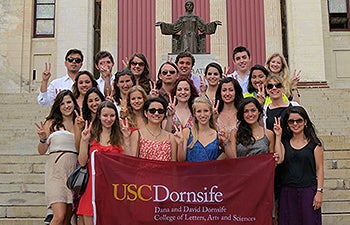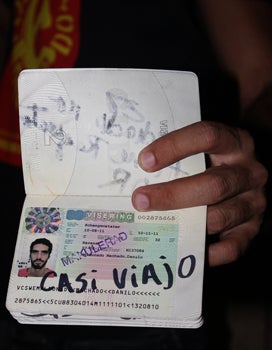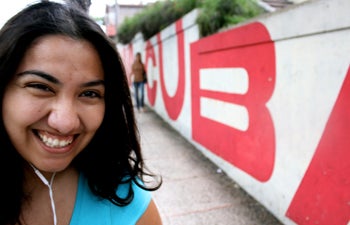Contradicting Cuba
In a joint effort between USC Dornsife and the USC Annenberg School for Communication and Journalism, 20 USC students traveled to Havana, Cuba, this summer for a 10-day study of the island’s political, economic and social conditions.
Students from the fields of international relations, journalism, public relations and public diplomacy were led by Pamela Starr, associate professor of teaching in USC Dornsife’s School of International Relations, and USC Annenberg Professor Roberto Suro.
For two weeks, classroom sessions were held in Los Angeles, where students were given an overview on the history of the country and its relations with the United States. Divided into an international relations and journalism class, the group was directed to examine the complex nature of the bilateral relations from varying, opposing angles.
The USC Dornsife students were participating in a Problems Without Passports (PWP) program.

USC Dornsife and USC Annenberg students gather in front of the alma mater statue at the University of Havana. Photo by Pamela Starr.
“For students of international relations, Cuba was an absolutely amazing laboratory to undertake research on foreign policy,” Starr said. “The Dornsife students in our group had learned that domestic politics and national characteristics influence the interactions among nations. Yet fully comprehending how this dynamic plays out in the real world is difficult without a firsthand experience that drives this reality home.”
To this end, Cuba was a perfect case study — an unknown and complex place embarking on wide-ranging reforms and where domestic politics sits at center-stage of its relationship with the United States, she said.
“I can’t imagine a better way to learn about the importance of national differences in international affairs,” Starr added.
On Memorial Day weekend, the group traveled to Washington, D.C., where students met with senior government and political think tanks officials. In these discussions, students worked to grasp an understanding of Cuba through the lens of American diplomacy.
From the nation’s capital, the group flew to Miami for meetings with various anti-Castro groups and departed for Cuba the following day.
Suro said the island was an ideal place for students to experience a nation undergoing dramatic change. The longtime communist country recently announced its desire to break a 50-year-old communication deadlock with the United States.
“The course was built to wreck their preconceptions, throw various points of view at them and then have very contradictory experiences on the island, where they heard all kinds of points of view — exponents of the regime and critics of it,” Suro said.
Starr said students in her previous PWP courses expressed to her how much they learned from the experience.
“But never have I had the reaction I received from the Cuba course,” Starr said. “Multiple students told me that the experience changed their lives.”
USC Dornsife’s international relations junior Veronica Werhane was one of those students.
“When I first arrived in Havana, I felt like I was dropped right into the middle of history,” she said. “It was surreal to me that I was beginning a 10-day experience that few Americans will ever have.”
The group stayed in a hotel in the downtown neighborhood of Vedado, across the street from the University of Havana, which lies in close proximity to numerous nightclubs, bars and Havana’s famous seawall, the Malecón.
The students dove into Cuba’s jumbled communist culture.
“Being out of the classroom and experiencing Cuba for myself allowed me to see that Cuba is a country of contradictions,” Werhane said. “Everything from its dual-monetary system to social mobility is completely contradictory and opposite of what I’ve learned as an American.”
It was exactly the type of unfamiliar venture that Starr and Suro wanted students to have.

Known as Cuba’s “graffiti king” Danilo Maldonado a.k.a. El Sexto shows his passport, which he has altered to reflect the travel restrictions in Cuba. Inscribed is the phrase “casi viajo,” which means “(I) almost traveled.” Photo by Karen Graciela Calderon.
“That kind of experience is such an important part of intellectual growth — of learning how to question things, of saying: I don’t know what to believe,” Suro said. “What is my point of view here, how do I establish perspective?”
For most of their stay in Cuba, students followed a rigid schedule of morning sessions at the University of Havana followed by culturally immersive excursions throughout the city.
At the university, professors from a wide array of fields — journalism, politics, foreign relations and economics — gave private lectures, which were followed by question-and-answer sessions.
The students, who endured the Caribbean heat and humidity and had no telephone or Internet access, spoke with enthusiasm about their field trips.
Highlights from the activities included speaking with officials from the National Center for Sexual Education (CENESEX), an educational, research and assistance institution in the area of human sexuality in Cuba. The also enjoyed witnessing the convergence of capitalism and communism through a tour of the city’s food markets.
“One of my favorite experiences was going to the state-run markets that sell state-grown food and the markets that sell privately grown food,” said Angeli Agrawal, a senior majoring in business administration and international relations. “It represents the ways Cuba has changed. The quality and prices at the state markets were low, but if you are willing and have money to pay for privately grown food, there is availability.”
Students also met and exchanged perspectives with students from Havana’s Institute of International Relations, an experience that Starr said was key for the group to breach the barriers between the American and Cuban cultures.
“Being able to talk with other young people made them realize how much they have in common — everything from music and classes to finding the best, cheapest places to eat,” Starr said. “It made it easier for them to overcome the cultural legacy of mistrust on both sides.”
Apart from their course-required assignments and outings, many students found time to conduct independent research.
Megan Sweas (M.A., journalism, ’12) wrote a piece for GlobalPost concerning the state of gay rights in the island. She said this specific foreign-reporting experience taught her the importance of understanding multiple perspectives when analyzing subjects.
“It gives me confidence going forward, when I’m reporting on stories that are complicated and doing international reporting from different locations,” she said. “I found out I’m able to report here on a very complex situation. If I can do that, what else can I do?”
Other independent research projects explored subjects such as the impact of tourism revenue on Cuba’s growing class system, Havana’s oppressive culture of prostitution and the city’s bustling, diverse music scene.
“It was the most invaluable trip to me in so many ways,” Agrawal said. “I got to see a living, breathing socialist atmosphere, and it still exists. It’s not a big, bad thing.”
Indeed, the trip pulled back the curtain on Cuba for the student travelers.

Karen Graciela Calderon, a graduate student in public diplomacy at USC Annenberg School for Communication and Journalism, and in USC Dornsife, in Havana, Cuba. Photo by Juan Espinoza.
“It opened the students’ eyes to a place that historically has been completely closed to us,” Starr said. “They were allowed to experience a culture that had seemed foreign and mysterious, and they found out that it really wasn’t that mysterious. It’s populated by people who are like us in many ways.”
Starr and Suro aim to take another group to Havana next summer.
“It’s an important example of what you can gain from international study,” Suro said. “It’s learning about another country in another country, spending time with young people someplace else. It’s having all of your assumptions challenged.”
USC Dornsife’s Pamela J. Johnson contributed to this report.